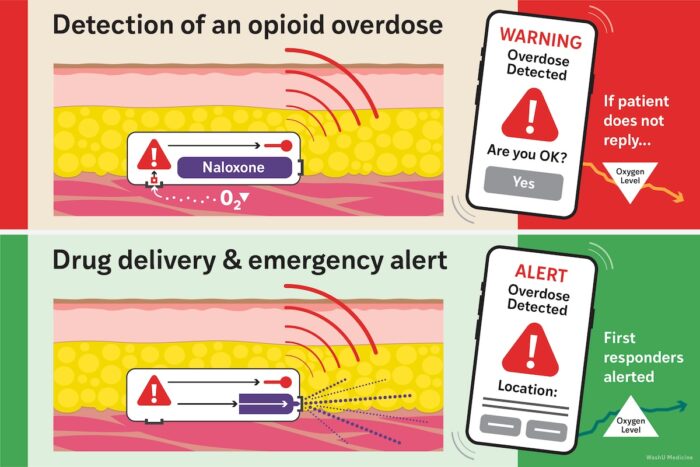A team from Washington University School of Medicine in St. Louis and Northwestern University in Chicago has developed a device that may rescue people from overdose without bystander help. In animal studies, the researchers found that the implantable device detects an overdose, rapidly delivers naloxone to prevent death and can alert emergency first responders.
The findings are available Oct. 23 in Science Advances.
“Naloxone has saved many lives,” said Robert W. Gereau, PhD, the Dr. Seymour and Rose T. Brown Professor of Anesthesiology and director of the WashU Medicine Pain Center. “But during an overdose, people are often alone and unable to realize they are overdosing. If someone else is present, they need access to naloxone — also known as Narcan — and need to know how to use it within minutes. We identified an opportunity to save more lives by developing a device that quickly administers naloxone to at-risk individuals without human intervention.”
Prescription opioids – such as oxycodone – have helped people manage the physical and mental challenges of daily debilitating pain. But the addictive properties of painkillers can lead to their misuse and abuse, which are among the driving forces behind the opioid epidemic. In addition, cheap and easy-to-access synthetic drugs – fentanyl, for example – have flooded the illicit market. Such ultrapotent drugs have accelerated the rise in overdose deaths in the U.S. and were responsible for roughly 70% of such deaths in 2023.
The researchers worked with experts in engineering and material sciences led by John A. Rogers, PhD, a professor of materials science and engineering, biomedical engineering and neurological surgery at Northwestern University, to develop a device – the Naloximeter – that uses a drop in oxygen levels as a signal for a potential overdose. Overdosing on opioids leads to slow and shallow breathing. Minutes after the drugs begin to impact respiratory function, breathing stops. Implanted under the skin, the Naloximeter senses oxygen in the surrounding tissues, sending a warning notification to a mobile application if the levels drop below a threshold. If the user doesn’t abort the rescue process within 30 seconds, the device releases stored naloxone.

Implanted under the skin, the Naloximeter, developed by researchers at WashU Medicine and Northwestern University, senses dropping oxygen in the surrounding tissues and sends a warning notification to a mobile application. If the user doesn’t engage with the warning message within 30 seconds, the device releases stored naloxone and can send an alert to first responders.
The researchers implanted the device in the neck, chest or back of small and large animals. The device detected signs of overdose within a minute of dropping oxygen levels, and all animals fully recovered within five minutes of receiving naloxone from the devices.
Naloxone displaces harmful opioids from receptors on the surface of brain cells, altering the cells’ activity. But the drug doesn’t stick around; when the opioids reoccupy and reactivate the receptors, overdose symptoms can return. To provide additional support, the device relays an emergency alert to first responders.
“An additional benefit of calling first responders is that it helps people re-engage with health-care providers,” said Jose Moron-Concepcion, PhD, the Henry E. Mallinckrodt Professor of Anesthesiology at WashU Medicine and an author on the study. “We want to save people from dying from an overdose and also reduce harm from opioids by helping people access the resources and treatments to prevent future overdoses from occurring.”
The researchers were awarded a patent – with some help from the Office of Technology Management at WashU – to protect the intellectual property of the device.
“The Naloximeter is a proof-of-concept platform that isn’t limited to the opioid crisis,” said Joanna Ciatti, a graduate student in Rogers’ lab. “This technology has far-reaching implications for those threatened by other emergent medical conditions such as anaphylaxis or epilepsy. Our study lays important groundwork for future clinical translation. We hope others in the field can build off of these findings to help make autonomous rescue devices a reality.”

